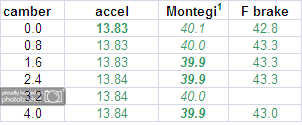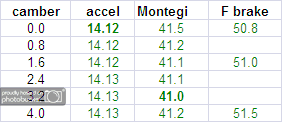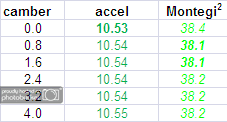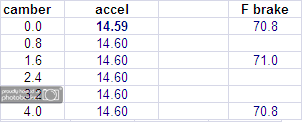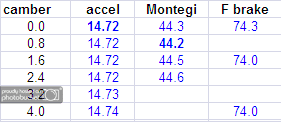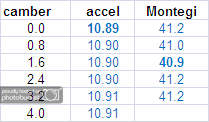nomis3613
Premium
- 831
Edit 11 Sep 2013: Please see this post below for updated testing: https://www.gtplanet.net/forum/showthread.php?p=8811231#post8811231 The results are slightly different 
In hindsight, it appears that the original testing and analysis (below the line in this post) had the following problems:
- Acceleration testing affected by AT gearbox hitting the rev limiter for some tests
- Drawing conclusions for brake test results without considering measurement accuracy (ie most of the results are within 1 metre)
- Similarly for the understeer results, focussing on peaks and troughs due to measurement accuracy, rather than looking at the overall trend.
Woops!
--------------------------------
Hi folks,
I've been doing some testing on the effects of camber. Thought I'd share them in case anyone is interested. (sorry if the graphs don't work, I have tried to make them compatible with most programs, but I am using excel 2007 so I hope it worked)
Basically I tested braking distance, cornering grip and acceleration time for camber angles between 0 and 2 degrees to see if I could find any general trends (the first test went up to 4.2 degrees, but nothing interesting happens up there, so after that I only went up to 2 degrees because the tests are very time consuming). Tests were conducted on the Plymouth Superbird (first with SM tyres, then with RH) and Opel Speedster Turbo (RM tyres).
Acceleration grip was tested using 0-400m times.
Braking grip was tested by measuring stopping distance (using the data logger) from 250-100 km/h. The Opel Speedster brakes are not powerful enough to cause the rear tyres to skid (hence the test results would not be accurate) so I was unable to test rear braking on this car. Anyway, the rear braking tests are not very good in general because the results are so close to each other.
Cornering grip for the front tyres was tested by lap times at Motegi Twin Ring. So that I could plot all the results on the same graph (which turned out to be confusing so I removed it anyway), the numbers in the table are lap times minus 30 seconds (eg 13.3 = 43.3s lap time). The car was set up to heavily understeer, so that any increase in front grip would lower the lap time.
Cornering grip for the rear tyres was not possible. I tried to do a similar test with a heavily oversteering car, but the lap times were all over the place (and I kept spinning!). Also, an oversteering car is more agile, so an increase in rear grip would not always mean a faster lap.
Feel free to question my testing methods, no offence will be taken! And I'm interested to see what trends you folks find.
Simon

In hindsight, it appears that the original testing and analysis (below the line in this post) had the following problems:
- Acceleration testing affected by AT gearbox hitting the rev limiter for some tests
- Drawing conclusions for brake test results without considering measurement accuracy (ie most of the results are within 1 metre)
- Similarly for the understeer results, focussing on peaks and troughs due to measurement accuracy, rather than looking at the overall trend.
Woops!
--------------------------------
Hi folks,
I've been doing some testing on the effects of camber. Thought I'd share them in case anyone is interested. (sorry if the graphs don't work, I have tried to make them compatible with most programs, but I am using excel 2007 so I hope it worked)
Basically I tested braking distance, cornering grip and acceleration time for camber angles between 0 and 2 degrees to see if I could find any general trends (the first test went up to 4.2 degrees, but nothing interesting happens up there, so after that I only went up to 2 degrees because the tests are very time consuming). Tests were conducted on the Plymouth Superbird (first with SM tyres, then with RH) and Opel Speedster Turbo (RM tyres).
Acceleration grip was tested using 0-400m times.
Braking grip was tested by measuring stopping distance (using the data logger) from 250-100 km/h. The Opel Speedster brakes are not powerful enough to cause the rear tyres to skid (hence the test results would not be accurate) so I was unable to test rear braking on this car. Anyway, the rear braking tests are not very good in general because the results are so close to each other.
Cornering grip for the front tyres was tested by lap times at Motegi Twin Ring. So that I could plot all the results on the same graph (which turned out to be confusing so I removed it anyway), the numbers in the table are lap times minus 30 seconds (eg 13.3 = 43.3s lap time). The car was set up to heavily understeer, so that any increase in front grip would lower the lap time.
Cornering grip for the rear tyres was not possible. I tried to do a similar test with a heavily oversteering car, but the lap times were all over the place (and I kept spinning!). Also, an oversteering car is more agile, so an increase in rear grip would not always mean a faster lap.
Feel free to question my testing methods, no offence will be taken! And I'm interested to see what trends you folks find.
Simon
Attachments
Last edited:



 .
. Updated results below:
Updated results below:  .
. .
.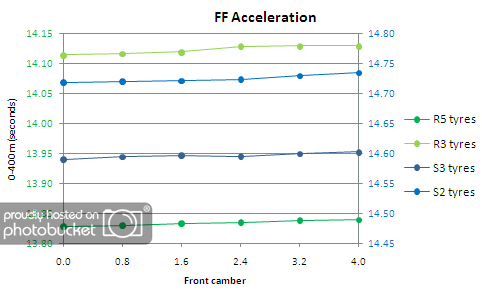
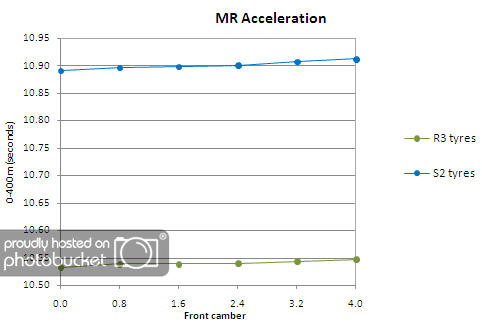

 But also the hardest to measure.
But also the hardest to measure. 
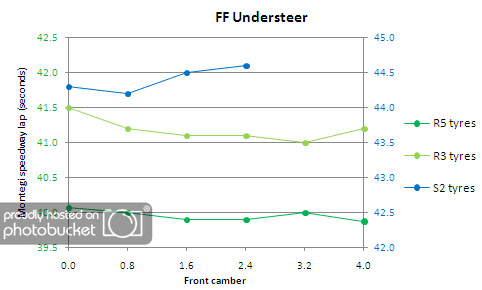
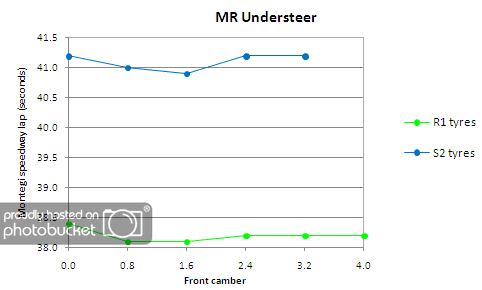
 Given how hard it was to get consistent results for dragging an understeering car around by its nose, I suggest it would be impossible to get meaningful measurements of rear grip!
Given how hard it was to get consistent results for dragging an understeering car around by its nose, I suggest it would be impossible to get meaningful measurements of rear grip!